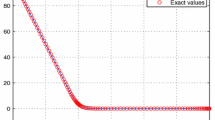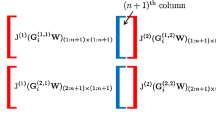Abstract
The aim of this paper is to contribute a new second-order pseudo-spectral method via a non-uniform distribution of the computational nodes for solving multi-asset option pricing problems. In such problems, the prices are required to be as accurately as possible around the strike price. Accordingly, the proposed modification of the Chebyshev–Gauss–Lobatto points would concentrate on this area. This adaptation is also fruitful for the non-smooth payoffs which cause discontinuities in the strike price. The proposed scheme competes well with the existing methods such as finite difference, meshfree, and adaptive finite difference methods on several benchmark problems.






Similar content being viewed by others
References
Abell, M.L., Braselton, J.P.: Mathematica by Example, 5th edn. Academic Press, Dordrecht (2017)
Borovkova, S., Permana, F., der Weide, J.V.: American basket and spread option pricing by a simple binomial tree. J. Deriv. 19, 29–38 (2012)
Butcher, J.C.: Numerical Methods for Ordinary Differential Equations, 2nd edn. Wiley, England (2008)
Company, R., Egorova, V.N., Jódar, L., Soleymani, F.: A local radial basis function method for high-dimensional American option pricing problems. Math. Model. Anal. 23, 117–138 (2018)
Dang, D.M., Christara, C.C., Jackson, K.R.: An efficient graphics processing unit-based parallel algorithm for pricing multi-asset American options. Concurr. Computat. Pract. Exp. 24, 849–866 (2012)
d’Halluin, Y., Forsyth, P.A., Labahn, G.: A penalty method for American options with jump diffusion processes. Numer. Math. 97, 321–352 (2004)
Ehrhardt, M., Günther, M., ter Maten, E.J.W.: Novel Methods in Computational Finance. Springer, Switzerland (2017)
Fornberg, B.: A Practical Guide to Pseudospectral Methods. Cambridge University Press, Cambridge (1996)
Gad, K.S.T., Pedersen, J.L.: Rationality parameter for exercising American put. Risks 3, 103–111 (2015)
Geske, R., Shastri, K.: Valuation by approximation: a comparison of alternative approaches. J. Func. Quant. Anal. 20, 45–71 (1985)
Giribone, P.G., Ligato, S.: Option pricing via radial basis functions: performance comparison with traditional numerical integration scheme and parameters choice for a reliable pricing. Int. J. Financ. Eng. 2, 1550018 (2015)
Glasserman, P.: Monte Carlo Methods in Financial Engineering. Springer, New York (2003)
Gzyl, H., Milev, M., Tagliani, A.: Discontinuous payoff option pricing by Mellin transform: a probabilistic approach. Financ. Res. Lett. 20, 281–288 (2017)
Hout, K.J.I., Foulon, S.: ADI finite difference schemes for option pricing in the Heston model with correlation. Int. J. Numer. Anal. Model. 7, 303–320 (2010)
Ikonen, S., Toivanen, J.: Operator splitting methods for American option pricing. Appl. Math. Lett. 17, 809–814 (2004)
Janson, S., Tysk, J.: Feynman–Kac formulas for Black–Scholes-type operators. Bull. Lond. Math. Soc. 38, 269–282 (2006)
Kangro, R., Nicolaides, R.: Far field boundary conditions for Black–Scholes equations. SIAM J. Numer. Anal. 38, 1357–1368 (2000)
Khaliq, A.Q.M., Voss, D.A., Kazmi, K.: Adaptive \(\theta \)-methods for pricing American options. J. Comput. Appl. Math. 222, 210–227 (2008)
Knapp, R.: A method of lines framework in Mathematica. J. Numer. Anal. Indust. Appl. Math. (JNAIAM) 3, 43–59 (2008)
Kovalov, P., Linetsky, V., Marcozzi, M.: Pricing multi-asset American options: a finite element method-of-lines with smooth penalty. J. Sci. Comput. 33, 209–237 (2007)
Kressner, D., Tobler, C.: Krylov subspace methods for linear systems with tensor product structure. SIAM J. Matrix Anal. Appl. 31, 1688–1714 (2010)
Leentvaar, C.C.W.: Pricing multi-asset options with sparse grids. PhD Thesis, TU Delft, The Netherlands (2008)
Lötstedt, P., Persson, J., von Sydow, L., Tysk, J.: Space-time adaptive finite difference method for European multi-asset options. Comput. Math. Appl. 53, 1159–1180 (2007)
Martín-Vaquero, J., Khaliq, A.Q.M., Kleefeld, B.: Stabilized explicit Runge–Kutta methods for multi-asset American options. Comput. Math. Appl. 67, 1293–1308 (2014)
Milovanović, S., von Sydow, L.: Radial basis function generated finite differences for option pricing problems. Comput. Math. Appl. 75, 1462–1481 (2017)
Milovanović, S., Shcherbakov, V.: Pricing derivatives under multiple stochastic factors by localized radial basis function methods (2018). arXiv:1711.09852
Nielsen, B.F., Skavhaug, O., Tveito, A.: Penalty methods for the numerical solution of American multi-asset option problems. J. Comput. Appl. Math. 222, 3–16 (2008)
Ramage, A., von Sydow, L.: A multigrid preconditioner for an adaptive Black–Scholes solver. BIT 51, 217–233 (2011)
Reddy, S.C., Trefethen, L.N.: Stability of the method of lines. Numer. Math. 62, 235–267 (1992)
Shcherbakov, V.: Radial basis function partition of unity operator splitting method for pricing multi-asset American options. BIT 56, 1401–1423 (2016)
Shcherbakov, V., Larsson, E.: Radial basis function partition of unity methods for pricing vanilla basket options. Comput. Math. Appl. 71, 185–200 (2016)
Sofroniou, M., Knapp, R.: Advanced Numerical Differential Equation Solving in Mathematica. Wolfram Mathematica, Tutorial Collection, USA (2008)
Tavella, D., Randall, C.: Pricing Financial Instruments: The Finite Difference Method. Wiley, New York (2007)
Traub, J.F.: Iterative Methods for Solution of Equation. Prentice-Hall, Englewood Cliffs (1964)
Trefethen, L.N., Embree, M.: Spectra and Pseudospectra. The Behavior of Nonnormal Matrices and Operators. Princeton Unversity Press, Princeton and Oxford (2005)
van Dorsselaer, J.L.M., Kraaijevanger, J.F.B.M., Spijker, M.N.: Linear stability analysis in the numerical solution of initial value problems. Acta Numerica 2, 99–237 (1993)
von Sydow, L., Höök, L.J., Larsson, E., Lindström, E., Milovanović, S., Persson, J., Shcherbakov, V., Shpolyanskiy, Y., Sirén, S., Toivanen, J., Waldén, J., Wiktorsson, M., Levesley, J., Li, J., Oosterlee, C.W., Ruijter, M.J., Toropov, A., Zhao, Y.: BENCHOP—the BENCHmarking project in option pricing. Int. J. Comput. Math. 92, 2361–2379 (2015)
Yousuf, M., Khaliq, A.Q.M., Liu, R.: Pricing American options under multi-state regime switching with an efficient \(L\)-stable method. Int. J. Comput. Math. 92, 2530–2550 (2015)
Acknowledgements
The author is grateful to two anonymous referees and the handling editor for several corrections and comments, which directly contribute to the readability and reliability of the current paper.
Author information
Authors and Affiliations
Corresponding author
Additional information
Communicated by Elisabeth Larsson.
Appendix
Appendix
We here provide the PDE formulation in Option Problem 4 with the initial and boundary conditions given in Sect. 2 for interested readers as follows.
Rights and permissions
About this article
Cite this article
Soleymani, F. Pricing multi-asset option problems: a Chebyshev pseudo-spectral method. Bit Numer Math 59, 243–270 (2019). https://doi.org/10.1007/s10543-018-0722-0
Received:
Accepted:
Published:
Issue Date:
DOI: https://doi.org/10.1007/s10543-018-0722-0




